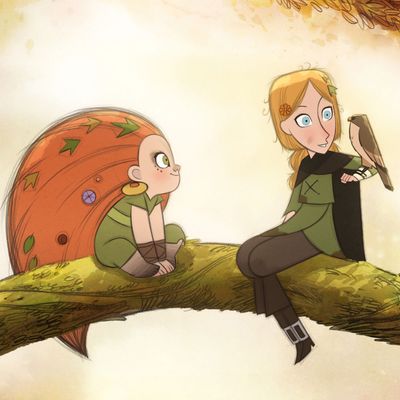
It’s like oxygen, honestly. Anyone who has longed for a return to the days of hand-drawn animation won’t just feel charmed by Irish directors Tomm Moore and Ross Stewart’s Wolfwalkers, they’ll feel saved. There’s no shiny, metallic sense of perfection or — God forbid, realism — to the imagery in this beautiful fable about a young girl discovering acceptance and adventure among the wolves. Instead, it’s the old magic, the one that captivated so many of us when we were kids and continues to do so: genuine drawings (and brushstrokes, and tapestries, and woodcuts) come to life, like an errant act of imagination made real. It’s glorious, gorgeous, and more than a little profound.
Moore also directed the Oscar-nominated The Secret of Kells (2009) and Song of the Sea (2014), magnificent films that took myth and history not just as narrative inspirations but as formal ones; Kells, for example, looked and felt and even moved like an illuminated medieval manuscript, like you were flipping pages in an old, timeless, mystical book you might have discovered in a primeval forest. Something similar happens in Wolfwalkers, where the ever-shifting texture of the imagery expresses ideas and feelings mere dialogue and incident can’t.
The story follows a young English girl, Robyn (voiced by Honor Kneafsey), who has arrived in an Irish town overseen by a domineering, Oliver Cromwell–style Lord Protector (voiced by Simon McBurney). Robyn’s father (Sean Bean), a professional hunter, has been tasked with ridding this town and its nearby forests of wolves. Among those beasts, however, is Mebh Óg MacTíre (Eva Whittaker), a girl by day who becomes a wolf when she sleeps — or, rather, she astral projects into the spirit of a wolf, so that her human body continues to lie dormant while her lupine one cavorts in the woods.
It’s the werewolf myth, without the malevolent overtones: Far from being vicious monsters, wolfwalkers actually have supernatural powers of healing. It’s also devoid of any shame: Even as a human, Mebh proudly leaps around on all fours, sprints through forests, howls, and roars — her great mane of red hair sailing this way and that, as if she’s harnessing the very power of nature. Wolfwalker isn’t her alter ego; it’s her identity, her innate being. But Mebh is also a child looking for her mom: The girl’s mother (also a wolfwalker) lies asleep in their lair, unable to wake up, which suggests that the woman’s wolf-persona has been captured somewhere and can’t return to her child and her tribe. Mom’s mane of hair is even more impressive than Mebh’s, and encircles her sleeping form like a giant, red, protective halo — the round, comforting pattern speaks of our longing for warmth, community, completion, belonging. This is the wonder of Wolfwalkers: The simple image of a quietly sleeping mother, unable to wake and embrace her crying daughter, suggests a whole complicated universe of heartbreaking truths, none of which need to be articulated to be felt. You just fall apart looking at mother and child.
Soon enough, Robyn falls in with Mebh and her tribe, and becomes a wolfwalker herself, which, as one might imagine, causes some trouble with her kindly but misunderstanding and melancholy father, not to mention the psychotic, puritanical Lord Protector. The latter seeks to tame and trample the wilderness around this fortress town, not just as a demonstration of imperial strength but also because he disdains the legends and folklore of the wild. (In one interview, Moore has said that he was inspired by learning that during the Salem witch trials, anyone from Kilkenny, Ireland — where his studio is based — was immediately suspect.)
As the story becomes one of Robyn finding her place outside of society (maybe even with some innocently romantic overtones), Moore and Stewart’s backgrounds immerse us in the drama: The blocky, repetitive, ironclad solidity of the fortress town clashes with the dense, dreamy swirls of color and movement found in the forest and the fields. Similarly, the rough, shivering, sometimes even incomplete lines with which Robyn and Mebh are drawn contrast with the hard edges and ruthless angles of the Lord Protector and his lumbering, armored soldiers. As the conflict flares up, Wolfwalkers becomes as much a battle of line, texture, and movement as it does of characters. And wait until you see the downright avant-garde way that Moore, Stewart, and their team animate fire.
All this is not to suggest that Wolfwalkers is some kind of oblique, arty, pseudo-experimental film meant for grown-ups. It also happens to be quite moving and gripping, filled with joyous bursts of music, even some pop cues, and a climactic chase that is as exciting as it is visually striking. (The film I kept thinking of, believe it or not, was James Cameron’s Titanic.) Kids will be enchanted, adults will be enraptured. It’s somehow light as air yet overwhelming, both ineffable and unforgettable.
More Movie Reviews
- The Accountant 2 Can Not Be Taken Seriously
- Another Simple Favor Is So Fun, Until It Gets So Dumb
- Errol Morris Has Been Sucked Into the Gaping Maw of True Crime


